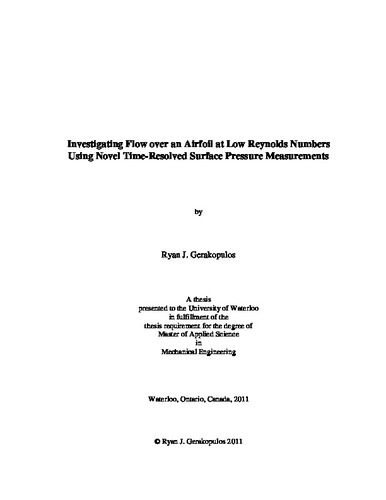| dc.description.abstract | An aluminum NACA 0018 airfoil testbed was constructed with 95 static pressure taps and 25 embedded microphones to enable novel time-resolved measurements of surface pressure. The main objective of this investigation is to utilize time-resolved surface pressure measurements to estimate salient flow characteristics in the separated flow region over the upper surface of an airfoil. The flow development over the airfoil was examined using hot wire anemometry and mean surface pressure for a range of Reynolds numbers from 80x103 to 200x103 and angles of attack from 0° to 18°. For these parameters, laminar boundary layer separation takes place on the upper surface and two flow regimes occur: (i) separation is followed by flow reattachment, so that a separation bubble forms and (ii) separation occurs without subsequent reattachment. Measurements of velocity and mean surface pressure were used to characterize the separated flow region and its effect on airfoil performance using the lift coefficient. In addition, the transition process and the evolution of disturbances were examined. The lift curve characteristics were found to be linked to the rate of change of the separation, transition, and reattachment locations with the angle of attack. For both flow regimes, transition was observed in the separated shear layer. Specifically, the amplification of disturbances within a band of frequencies in the separated shear layer resulted in laminar to turbulent transition. Validation of time-resolved surface pressure measurements was performed for Rec = 100x103 at α = 8° and α = 12°, corresponding to regimes of flow separation with and without reattachment, respectively. A comparative analysis of simultaneous velocity and time-resolved surface pressure measurements showed that the characteristics and development of velocity fluctuations associated with disturbances in the separated shear layer can be extracted from time-resolved surface pressure measurements. Specifically, within the separated flow region, the amplitude of periodic oscillations in the surface pressure signal associated with disturbances in the separated shear layer grew in the streamwise direction. In addition, the frequency at the spectral peak of the amplified disturbances in the separated shear layer was identified. Based on the results of the validation analysis, time-resolved surface pressure measurement analysis techniques were applied for a Reynolds number range from 60x103 to 130x103 and angles of attack from 6° to 16°. Within the separated flow region, the streamwise growth of surface pressure fluctuations is distinctly different depending on the flow regime. Specifically, within the separation bubble, the RMS surface pressure fluctuations increase in the streamwise direction and reach a peak just upstream of the reattachment location. The observed trend is in agreement with that observed for other separating-reattaching flows on geometries such as the forward and backward facing step and splitter plate with fence. In contrast to the separation bubble formation, when the separated shear layer fails to reattach to the airfoil surface, RMS surface pressure fluctuations increase in the streamwise direction with no maximum and the amplitude is significantly lower than those observed in the separation bubble. Surface pressure signals were further examined to identify the frequency, convective velocity, and spanwise uniformity of disturbances in the separated shear layer. Specifically, for both flow regimes, the fundamental frequency and corresponding Strouhal number exhibit a power-law dependency on the Reynolds number. Based on the available data for which velocity measurements were obtained in the separated flow region, the convective velocity matched the mean velocity at the wall-normal distance corresponding to the maximum turbulence intensity. A distinct increase in the convective velocity of disturbances in the separated shear layer was found when the airfoil was stalled in comparison to that found in the separation bubble. From statistical analysis of surface pressure signals in the spanwise direction, it was found that disturbances are strongly two-dimensional in the laminar portion of the separated shear layer and become three-dimensional through the transition process. | en |

